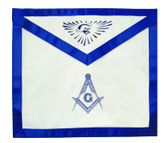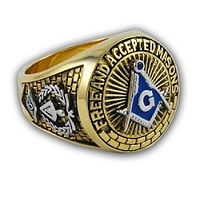Master Mason Apron
Why Do Freemasons Wear
a Masonic Apron?
The lambskin Master Mason apron derives from the working apron of the ancient stone masons.
It is an Emblem of innocence and the badge of a Freemason.
Thus, the apron is proudly compared with the noblest decorations of ancient Rome and of both ancient and modern Europe.
Master Mason Apron
on MasonZone.com
The Order of the Golden Fleece was of high repute as an Order of Knighthood. It was established in Flanders, France in 1429 by the Duke of Burgundy, a member of the then royal family, who selected the fleece for its badge because wool was the staple production of the country. Since that time, it has been considered as one of the most illustrious Orders of Europe.
The Roman Eagle was to Romans the ensign of imperial power. Made of silver or bronze, the Roman Eagle was placed atop the pole of the military standards (flags). (circa 104 B.C.)
The Order of the Garter, was and is, still considered the highest decoration that can be bestowed upon a subject by a sovereign of Great Britain. It is an order of chivalry or knighthood originating in medieval England. It is the pinnacle of honor in the United Kingdom to have the Order of the Garter bestowed upon you.
(From Mackey's Revised Encyclopedia of Freemasonry, 1929, Volume I, The New Kentucky Monitor, arranged by Brother Henry Pirtle, 1918, for the Grand Lodge of that State)
The Master Mason Apron
"....Lambskin or white leathern apron. It is an emblem of innocence and the badge of a Mason: more ancient than the Golden Fleece or Roman Eagle, and when worthily worn, more honorable than the Star and Garter, or any other Order that can be conferred upon you at this or any future period by king, prince, potentate, or any other person, except he be a Mason and within the Body of a just and legally constituted Lodge of such."
"It may be that, in the years to come, upon your head shall rest the laurel wreaths of victory; pendant from your breast may hang jewels fit to grace the diadem of an eastern potentate; yea, more than these:
...for with the coming light your ambitious feet may tread round after round the ladder that leads to fame in our mystic circle, and even the purple of our Fraternity may rest upon your honored shoulders;
...but never again by mortal hands, never again until your enfranchised spirit shall have passed upward and inward through the gates of pearl, shall any honor so distinguished, so emblematic of purity and all perfection, be bestowed upon you as this, which I now confer.
It is yours; yours to wear through an honorable life, and at your death to be placed upon the coffin which contains your earthly remains, and with them laid beneath the silent clods of the valley."
"Let its pure and spotless surface be to you an ever-present reminder of purity of life, of rectitude of conduct, a never-ending argument for higher thoughts, for nobler deeds, for greater achievements; and when at last your weary fee shall have reached the end of their toilsome journey,
...and from your nerveless grasp forever drop the working tools of a busy life, may the record of your life and conduct be as pure and spotless as this fair emblem which I place within your hands tonight;
...and when your trembling soul shall stand naked and alone before the great white throne, there to receive judgment for the deeds done while here in the body, may it be your portion to hear from Him who sitteth as Judge Supreme these welcome words:
'Well done, thou good and faithful servant, enter thou into the joy of thy Lord.'"
"I charge you-take it, wear it with pleasure to yourself and honor to the Fraternity."
(From Mackey's Revised Encyclopedia of Freemasonry, 1929, Volume I)
Innocence of Conduct and Purity of Heart
The Master Mason apron teaches the aspiring Mason that
none are admitted to that honor but such as were cleansed of all impurities of
both body and mind.
Purity of life and rectitude of conduct is essential
and necessary to gain admittance into that Celestial Lodge on High where the
Supreme Architect of the Universe forever presides.
In primitive times, it was an ecclesiastical (religious) decoration more than a civil decoration.
The earliest mention of the apron was when Melchizedek, with Abraham, started the priesthood. (circa 2100 B.C.) Melchizedek was the Most High Priest and the first to wear the apron as the badge of religious authority. The apron is a high honor and is the symbol of a holy man.
(From Signs and Symbols of Freemasonry, Dr. Oliver, Lexture X, Page 196)
Ancient Badge of Distinction
The apron appears to have been, in ancient times, an honorary badge of distinction. None but the superior orders of the priesthood were permitted to adorn themselves with ornamented girdles made of blue, purple and crimson, decorated with gold upon a background of fine white linen.
Historic Ceremonies of Investiture have been common to all nations of the Earth from the earliest periods.
The Indian, the Persian, the Jewish, the Ethiopian and
the Egyptian aprons, though equally superb, all bore a character distinct from
each other. Some were plain white.
Others were striped with blue,
purple and crimson. Some were of wrought gold...others were adorned and
decorated with superb tassels and fringes.
Israelites: Historically, among the Israelites, the girdle formed a part of the investiture of the priesthood.
Persia: The candidate was invested with a white apron.
Hindostan: A sash was used called the sacred zennar, which was substituted for the apron.
Essenes: The Jewish sect of the Essenes clothed their novices with a white robe.
Japanese: The Japanese practice certain rites of initiation, invest their candidates with a white apron, bound round the loins with a zone or girdle.
Scandanavia: The military genius of the people caused them to substitute a white shield, but its presentation was accompanied by an emblematic instruction not unlike that which is connected with the Freemason's apron.
Roman Priests: Roman priests wore white garments when they sacrificed.
Druids: The Druids changed the color of the garment presented to their initiates with each degree; white, however was the color appropriated to the last, or degree of perfection. It was, according to their ritual, intended to teach the aspirant that none were admitted to that honor but such as were cleansed from all impurities both of body and mind.
Formation of the Grand Lodge of England
At the time of the formation of the Grand Lodge of England, the Master Mason apron was white - no ornaments at first, and full size, similar in every respect to that of the Operative Mason's apron.
Color of a Master Mason Apron:
Due to the preservation of its symbolic character - its color and its material:
The color of a Master Mason apron should be pure unspotted white, which is esteemed as an emblem of innocence and purity.
Material of a Master Mason Apron:
A Master Mason apron must be made of lambskin. No
other substance, such as linen, silk or satin, could be substituted without
entirely destroying the emblematic character of the apron, for the material of
the Master Mason's apron constitutes one of the most important symbols of his
profession
....The lamb having always been considered as an appropriate
emblem of innocence.
Drill Apron: Your drill apron is symbolic
of your lambskin Master Mason apron.
Why, then, do Freemasons wear their lambskin Master Mason apron with such pride?
Honor: The reason the Master Mason apron is more
honorable than the Star and Garter is that all it teaches is exemplified by its
wearer.
Spiritual Knighthood: The Master Mason apron is a
reminder to the Master Mason to do no moral evil to any person. It speaks
to the charitable forgiveness of his brethren when they purposely or
non-purposely do him evil.
It is the emblem of his dedication to a
spiritual knighthood with which man virtuously rises above the crudeness and the
ignorance of men.
Dignity and Virtue: The Master Mason apron
should be worn with dignity and honor as it exemplifies man's virtues upon which
during his manhood, he may wear it both with pleasure to himself while honoring
the fraternity.
Most American Freemasons wear a Master Mason Apron which is 14 inches by 16 inches and is made of white, synthetic leather with Masonic symbols embroidered onto them in blue thread.
Some members wear an apron which has ties in the back, however most prefer the belted version. To keep them clean before and after lodge work, many Master Masons place them in zippered apron cases which have handles.
Master Mason Aprons on Amazon.com
Master Mason Apron
on Amazon.com
Royal Blue Satin Edging Masonic Apron
on Amazon.com
White Cloth with Royal Blue Satin Apron
on Amazon.com

Master Mason Apron
on Amazon.com

Hand Embroidered on Synthetic Leather Masonic Apron
on Amazon.com

Navy Blue and Silver Embroidered with Fringe
on Amazon.com

Embroidered and Fringed Apron
on Amazon.com

Hand Embroidered Master Mason Apron
on Amazon.com

Past Master Apron
on Amazon.com

Past Master Apron with Embroidery
on Amazon.com

Past Master Cloth Apron
on Amazon.com

Masonic Blue Lodge 15 Piece Machine Embroidery Apron Set
on Amazon.com

Masonic Blue Lodge Officers Apron Set of 11 Machine Embroidered Aprons
on Amazon.com

Apron Case - Blue Interior
on Amazon.com

Apron Case - Red Interior
on Amazon.com

Fold Out Apron Case
on Amazon.com

Real Men Wear Aprons (worn at lodge dinner events)
on Amazon.com
Related Pages:
Link to This Page: If you would like to link to this page to help others increase their Masonic knowledge, please feel free to do so.
5 Fast Methods To Find the Information You Want to Learn About
- Search Box - Use the Search Box at the top of your page.
- Site Map - Use my Site Map page to find the topics you are most interested in.
- Carousel - Use the carousel of pages at the top of your screen.
- Menu Icon - On MOBILE, click the MENU button at the top of each page.
- Masonic Books - Browse through a selection of Masonic books.










